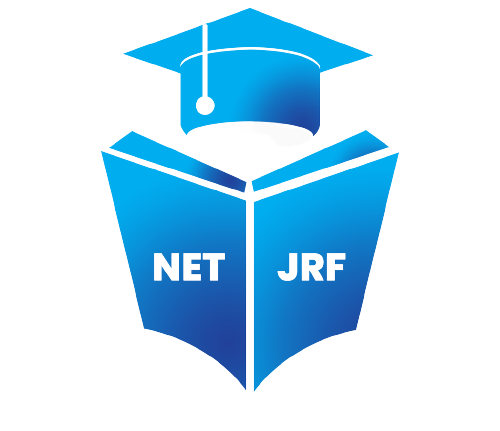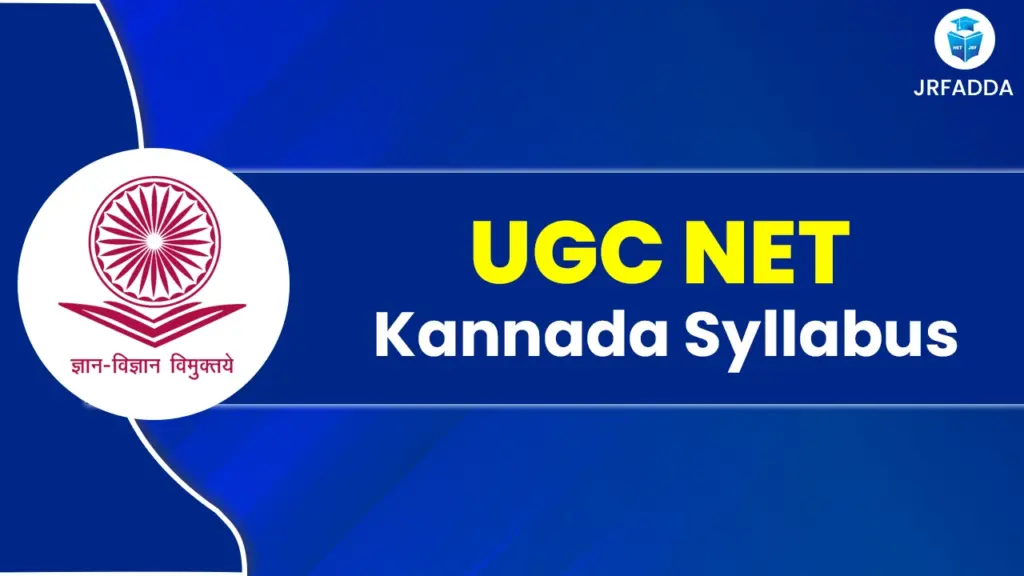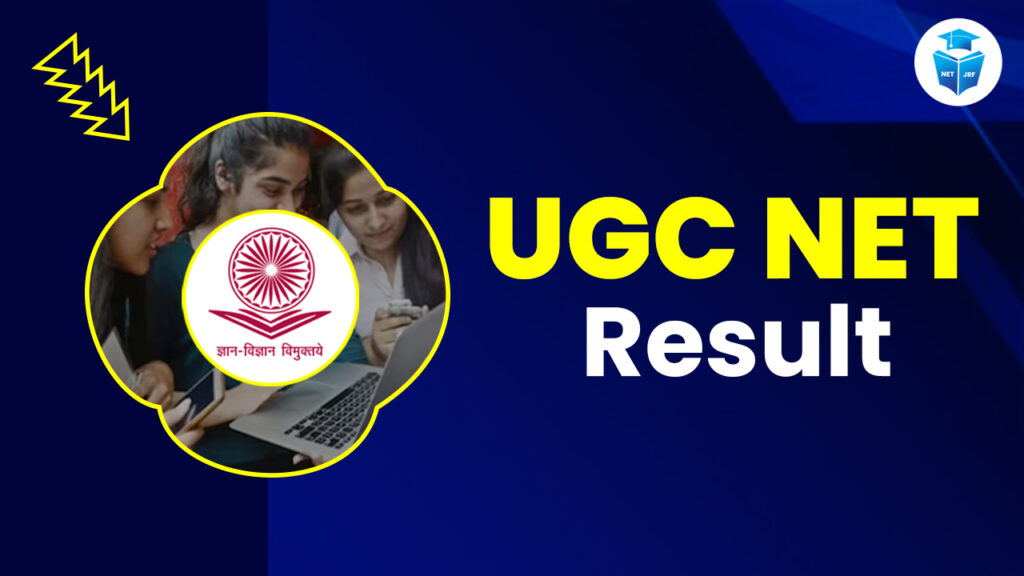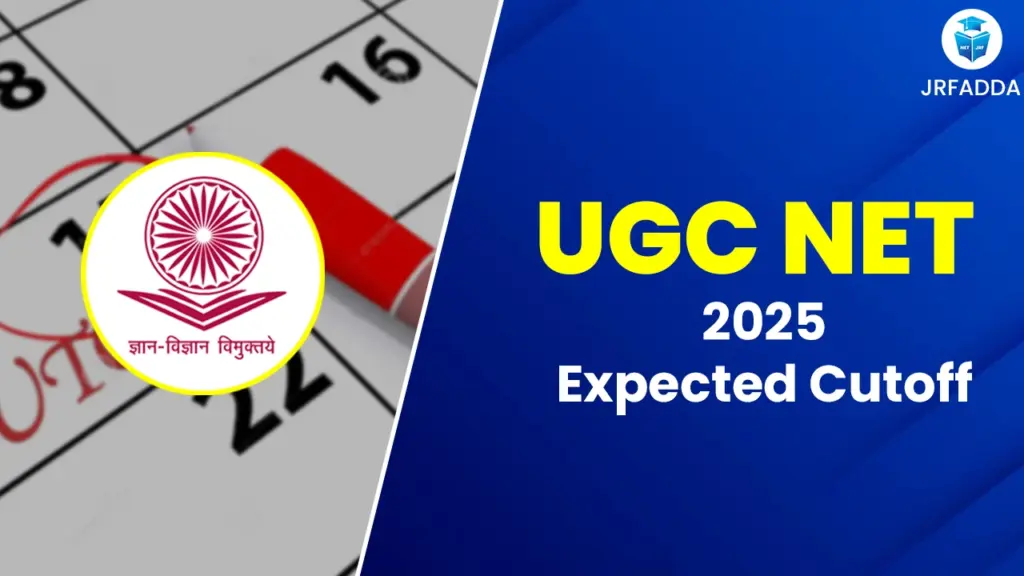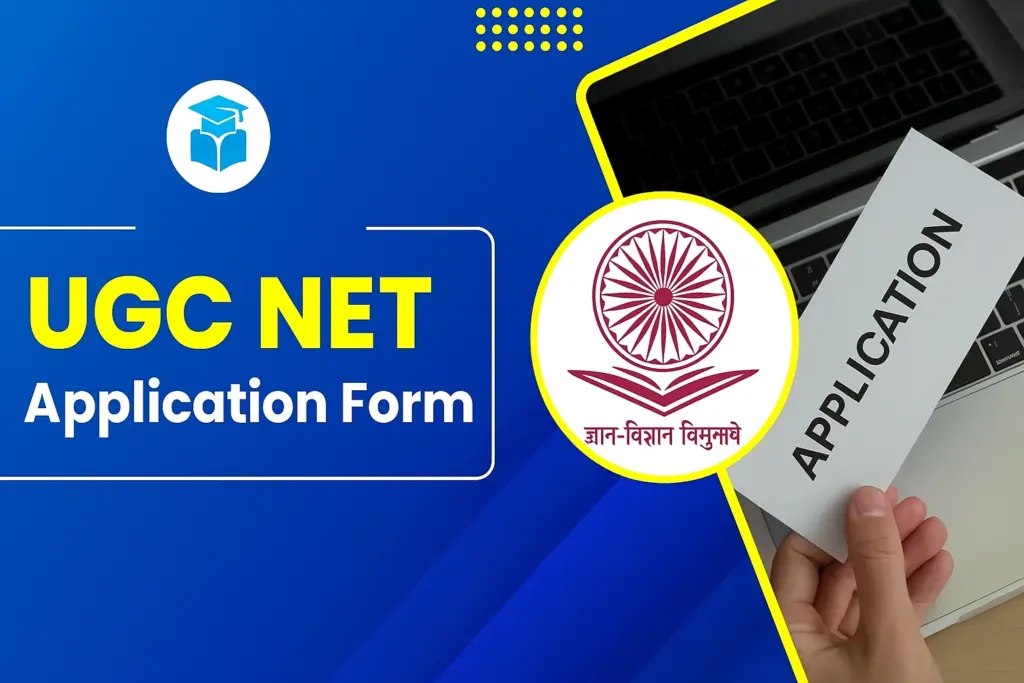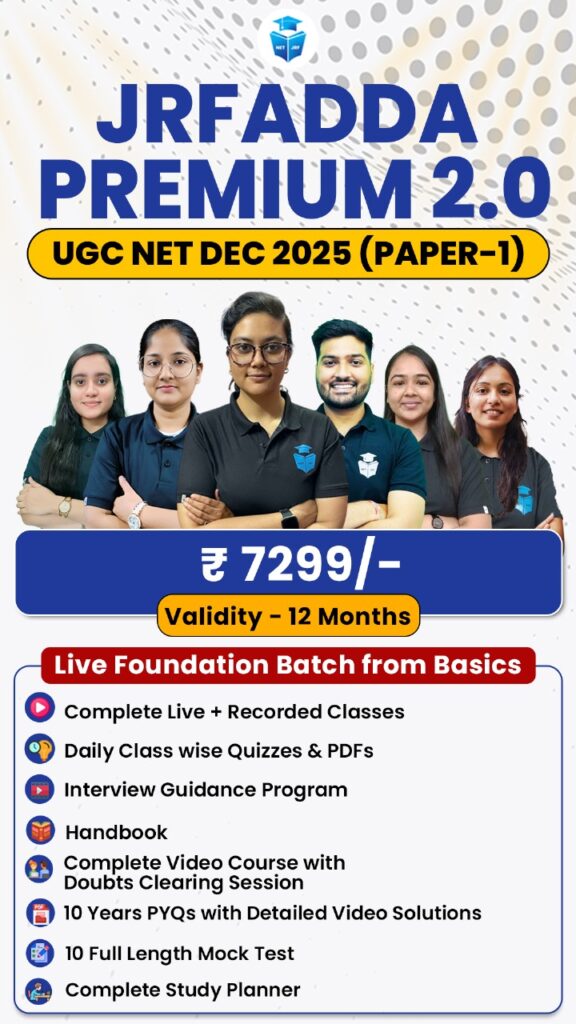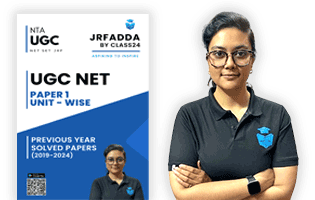The National Testing Agency (NTA) has officially published the UGC NET Kannada Syllabus 2025 for candidates aspiring to qualify for Assistant Professor and Junior Research Fellowship (JRF) roles. The Kannada subject code is 21. For effective and systematic preparation, aspirants should carefully review the syllabus, which is segmented into ten detailed units covering classical to contemporary Kannada literature, linguistics, and literary criticism.
UGC NET Kannada Syllabus 2025 Overview
The UGC NET exam conducted by NTA determines eligibility for Assistant Professorship and JRF. It is organized twice annually in online mode (CBT) and is available in Kannada for the Kannada subject. The exam consists of two papers lasting a total of 3 hours.
| Feature | Details |
| Exam Name | UGC NET 2025 |
| Conducting Body | National Testing Agency (NTA) |
| Purpose | Eligibility for Assistant Professor & JRF |
| Exam Frequency | Twice a year |
| Exam Mode | Computer-Based Test (CBT) |
| Medium of Exam | Kannada |
| Total Duration | 3 Hours (180 Minutes) |
| Papers | Paper I (General) & Paper II (Kannada) |
| Subject Code | 21 |
| Expected Dates | 21 June to 30 June 2025 (Tentative) |
| Official Website | ugcnet.nta.nic.in |
Also Read: UGC NET June 2025
UGC NET Kannada Syllabus PDF Download
For thorough preparation, candidates should download the official UGC NET Kannada Syllabus 2025 PDF issued by the NTA. The syllabus outlines specific topics under each unit, facilitating focused and efficient study. Download the PDF using the link below and revise all important concepts in Kannada literature and linguistics.
| Download UGC NET Kannada Syllabus 2025 PDF |
UGC NET Syllabus Paper 1 Unit Wise
Paper 1 is a common paper across all subjects, testing research, teaching aptitude, and reasoning skills. Excelling in Paper 1 is crucial for improving overall UGC NET scores.
| Unit No. | Topic | Description |
| Unit 1 | Teaching Aptitude | Nature, objectives, characteristics of teaching; learner’s traits; teaching methods |
| Unit 2 | Research Aptitude | Research types, ethics, process, thesis writing, methodologies |
| Unit 3 | Comprehension | Reading comprehension with interpretative questions |
| Unit 4 | Communication | Communication types, barriers, classroom communication |
| Unit 5 | Mathematical Reasoning & Aptitude | Number series, percentages, profit & loss, ratio, averages, time-speed-distance, data interpretation |
| Unit 6 | Logical Reasoning | Analogies, syllogisms, inductive & deductive reasoning, Venn diagrams |
| Unit 7 | Data Interpretation | Graphs, charts, tables interpretation |
| Unit 8 | Information & Communication Technology (ICT) | Basics of ICT, e-learning tools, internet & digital initiatives |
| Unit 9 | People, Development & Environment | Sustainable development, environmental issues, pollution, conservation |
| Unit 10 | Higher Education System | Governance, policies, regulatory bodies, evolution of higher education |
Download UGC NET Paper I Syllabus 2025 PDF
| UGC NET Paper I Syllabus 2025 | |
| English | Hindi |
Also Read: UGC NET Syllabus 2025 PDF Download
UGC NET Kannada Syllabus Paper 2 Unit Wise
Paper 2 is subject-specific, emphasizing Kannada language, grammar, literature (classical to modern), criticism, and linguistics. Below is a unit-wise overview:
| Unit | Title | Topics Covered |
| Unit 1 | Ancient Kannada Literature | – Pre-Inscriptional Literature: Halmadi, Ashoka’s Edicts, Badami, Tammatkallu, Jinavallabha, Nandisena inscriptions |
| – Ancient Eastern Literature: Durvinita, Tambuluracharya, Shyamakundacharya, Kavirajamarga, Vaddaradhana | ||
| – Ancient Kannada Literary Forms: Champoo (origin, characteristics, evolution) | ||
| – Themes: History-Mythology, Religion-Poetry, Violence-Nonviolence, Route-Native, Worldly-Spiritual, Materialistic, Resistance | ||
| Unit 2 | Medieval Kannada Literature | – Literary Forms: Vachana, Ragale, Shattadi, Sangatya, Tripadi, Kirtana, Shataka, Tattvapada |
| – Concepts: Devotion-experience, body, open-air temple, life-god, yoga-enjoyment | ||
| – Religion: Shaiva, Veerashaiva, Vaishnava, Jain, Natha, Kapalika, Lakulisha, Pashupati | ||
| – Royal Patronage: Chalukyas, Hoysalas, Rashtrakutas, Gangas, Kalachuris, Vijayanagara kings, Rattas, Lords of Mysore | ||
| – Poets & Works: Andaiah, Nemichandra, Rudrabhatta, Basavanna, Allama Prabhu, Akkamahadevi, others | ||
| Unit 3 | Modern Kannada Literature: Poetry | – Colonial History & Missionaries: Mackenzie, Mogling, Garrett, Kittel, Rice, Feit |
| – New Literary Genres: Lyric poem, sonnet, elegy, prose, narrative, epic poem | ||
| – Concepts: Nationalism, subnationalism, religion, socialism, class, gender politics, East-West, religious-science | ||
| – Important Poets: B.M. Srikanthayya, Govinda Pai, Kuvempu, D.V. Gundappa, others | ||
| Unit 4 | Modern Kannada Literature: Prose | – Literary Genres: Short story, novel, drama, biography, fine essay, autobiography, travel literature, ideological literature |
| – Major Authors: Gulwadi Venkataraya, Kuvempu, Shivarama Karanth, Mastive Iyengar, K.S. Narasimhaswamy, Triveni, others | ||
| Unit 5 | Linguistics, Dravidian Linguistics & Kannada History | – Language Nature & Characteristics: language, dialect, linguistic change, speech & writing |
| – Language Varieties: social & spatial | ||
| – Linguistics Methods: traditional & modern, Kannada grammatical heritage (Nagavarma II, Keshiraja, Bhattakalanka) | ||
| Unit 6 | Prose and Book Editing | – Prosthesis: Origin, development, terminology (rhythm, pitch, rhyme scheme, etc.) |
| – Letter/Color Circle: Sanskrit adaptation, letter circles, unique Karnataka examples | ||
| – Matra rhyme, elemental prosthesis, new Kannada prose terminology | ||
| Unit 7 | Poetry: Indian, Western & Kannada Mysticism | – Indian Poetry: concepts, characteristics, benefits, major mimamsakas & their works |
| – Western Poetics: nature, concepts (imitation, catharsis, grandeur, imagination, etc.) | ||
| Unit 8 | Folklore Study | – Definitions, history (global, colonial, postcolonial) |
| – Theories: nationalism, mythological, historical-geographical, structural, psychoanalytic, others | ||
| – Fieldwork: methods, ethics, data analysis | ||
| Unit 9 | Kannada Research, Literary Criticism & Cultural Studies | – Research: concept, history, methods, key texts |
| – Important Researchers: Shamba Joshi, Govinda Pai, Muli Thimmappaiah, R. Narasimhachar, others | ||
| Unit 10 | Comparative & Translated Literature | – Comparative Literature: concept, foundations |
| – Translated Literature: definitions, history, principles (obedience, conformity, joy, resolution) | ||
| – Translation Types: literal, emotional, metaphorical, adaptive, creative, etc. |
ಯುಜಿಸಿ ನೆಟ್ ಕನ್ನಡ ಪಠ್ಯಕ್ರಮ ಪತ್ರಿಕೆ 2
| ಯೂನಿಟ್ | ಶೀರ್ಷಿಕೆ | ಆವರ್ತಿತ ವಿಷಯಗಳು |
| ಯೂನಿಟ್ 1 | ಪ್ರಾಚೀನ ಕನ್ನಡ ಸಾಹಿತ್ಯ | – ಶಾಸನಪೂರ್ವ ಸಾಹಿತ್ಯ: ಹಳಮಿಡಿ, ಅಶೋಕನ ಶಾಸನಗಳು, ಬದಾಮಿ, ತಮ್ಮಟ್ಕಲ್ಲು, ಜಿನವಲ್ಲಭ, ನಂದಿಸೇನ ಶಾಸನಗಳು
– ಪ್ರಾಚೀನ ಪೂರ್ವ ಭಾರತ ಸಾಹಿತ್ಯ: ದುರ್ವಿನೀತ, ತಂಬೂಲಾಚಾರ್ಯ, ಶ್ಯಾಮಕುಂಡಾಚಾರ್ಯ, ಕವಿರಾಜಮಾರ್ಗ, ವಡ್ಡಾರಾಧನೆ – ಪ್ರಾಚೀನ ಸಾಹಿತ್ಯ ರೂಪಗಳು: ಚಂಪು (ಉದ್ಭವ, ಲಕ್ಷಣಗಳು, ಅಭಿವೃದ್ಧಿ) – ವಿಷಯಗಳು: ಇತಿಹಾಸ-ಪುರಾಣ, ಧರ್ಮ-कಾವ್ಯ, ಹಿಂಸಾ-ಅಹಿಂಸಾ, ಮಾರ್ಗ-ದೇಶಿ, लौಕಿಕ-ಅಧ್ಯಾತ್ಮಿಕ, ಭೌತಿಕ, ಪ್ರತಿರೋಧ |
| ಯೂನಿಟ್ 2 | ಮಧ್ಯಯುಗೀನ ಕನ್ನಡ ಸಾಹಿತ್ಯ | – ಸಾಹಿತ್ಯ ರೂಪಗಳು: ವಚನ, ರಾಗಲೆ, ಶಟ್ಟದಿ, ಸಂಗತ್ಯ, ತ್ರಿಪದಿ, ಕೀರ್ತನೆ, ಶತಕ, ತತ್ತ್ವಪದ
– ತತ್ತ್ವಗಳು: ಭಕ್ತಿ-ಅನುಭವ, ದೇಹ, ಬಯಲುಬಾಗಿಲು, ಜೀವನ-ದೈವ, ಯೋಗ-ಭೋಗ – ಧರ್ಮ: ಶೈವ, ವೀರಶೈವ, ವೈಷ್ಣವ, ಜೈನ, ನಾಥ, ಕಪಾಲಿಕ, ಲಕುಲೀಶ, ಪಶುಪತಿ – ರಾಜಾಶ್ರಯ: ಚಾಲುಕ್ಯ, ಹೊಯ್ಸಳ, ರಾಷ್ಟ್ರಕೂಟ, ಗಂಗ, ಕಲಚೂರಿ, ವಿಜಯನಗರ ಅರಸರು, ರಟ್ಟರು, ಮೈಸೂರು ದೊರೆಗಳು – ಕವಿಗಳು ಮತ್ತು ಕೃತಿಗಳು: ಅಂದಯ್ಯ, ನೇಮಿಚಂದ್ರ, ರುದ್ರಭಟ್ಟ, ಬಸವಣ್ಣ, ಅಲ್ಲಮ ಪ್ರಭು, ಅಕ್ಕಮಹಾದೇವಿ, ಇತರರು |
| ಯೂನಿಟ್ 3 | ಆಧುನಿಕ ಕನ್ನಡ ಸಾಹಿತ್ಯ: ಕಾವ್ಯ | – ವಸಾಹತು ಇತಿಹಾಸ ಮತ್ತು ಮಿಷನರಿ ಪ್ರಭಾವ: ಮ್ಯಾಕೆಂಜಿ, ಮೊಗ್ಲಿಂಗ್, ಗ್ಯಾರೆಟ್, ಕಿಟ್ಟೆಲ್, ರೈಸ್, ಫೈಟ್
– ಹೊಸ ಸಾಹಿತ್ಯ ಪ್ರಕಾರಗಳು: ಲಯಬದ್ಧ ಕವನ, ಸೊನೆಟ್, ವಿಳಾಪಕಾವ್ಯ, ಗದ್ಯ, ಕಥನ, ಮಹಾಕಾವ್ಯ – ತತ್ತ್ವಗಳು: ರಾಷ್ಟ್ರವಾದ, ಉಪರಾಷ್ಟ್ರವಾದ, ಧರ್ಮ, ಸಮಾಜವಾದ, ವರ್ಗ, ಲಿಂಗ ರಾಜಕೀಯ, ಪೂರ್ವ-ಪಶ್ಚಿಮ ಭಿನ್ನತೆ, ಧರ್ಮ-ವಿಜ್ಞಾನ – ಪ್ರಮುಖ ಕವಿಗಳು: ಬಿ.ಎಂ. ಶ್ರೀಕಂಠಯ್ಯ, ಗೋವಿಂದ ಪೈ, ಕುವೆಂಪು, ಡಿ.ವಿ. ಗುಂಡಪ್ಪ, ಇತರರು |
| ಯೂನಿಟ್ 4 | ಆಧುನಿಕ ಕನ್ನಡ ಸಾಹಿತ್ಯ: ಗದ್ಯ | – ಗದ್ಯ ಪ್ರಕಾರಗಳು: ಕಿರುಕಥೆ, ಕಾದಂಬರಿ, ನಾಟಕ, ಜೀವನಚರಿತ್ರೆ, ಸೊಗಸುಳ್ಳದ ಪ್ರಬಂಧ, ಆತ್ಮಚರಿತ್ರೆ, ಪ್ರವಾಸ ಸಾಹಿತ್ಯ, ತತ್ತ್ವ ಸಾಹಿತ್ಯ
– ಪ್ರಮುಖ ಲೇಖಕರು: ಗುಳ್ವಾಡಿ ವೆಂಕಟರಾಯ, ಕುವೆಂಪು, ಶಿವರಾಮ ಕಾರಂತ್, ಮಸ್ತಿ ವೆಂಕಟೇಶ ಅಯ್ಯಂಗಾರ್, ಕೆ.ಎಸ್. ನರಸಿಂಹಸ್ವಾಮಿ, ತ್ರಿವೇಣಿ, ಇತರರು |
| ಯೂನಿಟ್ 5 | ಭಾಷಾಶಾಸ್ತ್ರ, ದ್ರಾವಿಡ ಭಾಷಾಶಾಸ್ತ್ರ ಮತ್ತು ಕನ್ನಡ ಇತಿಹಾಸ | – ಭಾಷೆಯ ಸ್ವಭಾವ ಮತ್ತು ಲಕ್ಷಣಗಳು: ಭಾಷೆ, ಉಪಭಾಷೆ, ಭಾಷಾ ಬದಲಾವಣೆ, ಮಾತು ಮತ್ತು ಬರಹ
– ಭಾಷಾ ರೂಪಗಳು: ಸಾಮಾಜಿಕ ಮತ್ತು ಭೌಗೋಳಿಕ – ಭಾಷಾಶಾಸ್ತ್ರೀಯ ವಿಧಾನಗಳು: ಪರಂಪರಾ ಮತ್ತು ಆಧುನಿಕ, ಕನ್ನಡ ವ್ಯಾಕರಣ ಪರಂಪರೆ (ನಾಗವರ್ಮ II, ಕೇಶಿರಾಜ, ಭಟ್ಟಕಲಂಕ) |
| ಯೂನಿಟ್ 6 | ಗದ್ಯ ಮತ್ತು ಗ್ರಂಥ ಸಂಪಾದನೆ | – ಛಂದಸ್ಸು: ಮೂಲ, ಬೆಳವಣಿಗೆ, ತಂತ್ರಗಳು (ಛಂದಸ್ಸು, ಸ್ವರ, ಯಮಕ ಇತ್ಯಾದಿ)
– ಅಕ್ಷರ/ಬಣ್ಣ ಚಕ್ರ: ಸಂಸ್ಕೃತ ರೂಪಾಂತರ, ಅಕ್ಷರ ಚಕ್ರಗಳು, ಕರ್ನಾಟಕದ ವಿಶಿಷ್ಟ ಉದಾಹರಣೆಗಳು – ಮಾತ್ರಾ ಛಂದಸ್ಸು, ಮೂಲಘಟಕ ಛಂದಸ್ಸು, ಹೊಸ ಕನ್ನಡ ಗದ್ಯ ತಂತ್ರಗಳು |
| ಯೂನಿಟ್ 7 | ಕಾವ್ಯಶಾಸ್ತ್ರ: ಭಾರತೀಯ, ಪಾಶ್ಚಾತ್ಯ ಮತ್ತು ಕನ್ನಡ ಪರಮಾರ್ಥ ಕಾವ್ಯ | – ಭಾರತೀಯ ಕಾವ್ಯಶಾಸ್ತ್ರ: ತತ್ತ್ವಗಳು, ಲಕ್ಷಣಗಳು, ಉಪಯೋಗಗಳು, ಪ್ರಮುಖ ಮೀಮಾಂಸಕರು ಮತ್ತು ಅವರ ಕೃತಿಗಳು
– ಪಾಶ್ಚಾತ್ಯ ಕಾವ್ಯಶಾಸ್ತ್ರ: ಸ್ವಭಾವ, ತತ್ತ್ವಗಳು (ಅನುಕರಣ, ಕಾರುಣ್ಯ, ಭಾವಪ್ರಭಾವ, ಕಲ್ಪನೆ ಇತ್ಯಾದಿ) |
| ಯೂನಿಟ್ 8 | ಜನಪದ ಅಧ್ಯಯನ | – ವ್ಯಾಖ್ಯೆಗಳು, ಇತಿಹಾಸ (ಜಾಗತಿಕ, ವಸಾಹತು, ಉಪವಸಾಹತು)
– ಸಿದ್ಧಾಂತಗಳು: ರಾಷ್ಟ್ರವಾದ, ಪೌರಾಣಿಕ, ಇತಿಹಾಸ-ಭೌಗೋಳಿಕ, ഘಟನೆಯ, ಮನೋವೈಜ್ಞಾನಿಕ, ಇತರ – ಕ್ಷೇತ್ರ ಅಧ್ಯಯನ: ವಿಧಾನಗಳು, ನೈತಿಕತೆ, ಮಾಹಿತಿಯ ವಿಶ್ಲೇಷಣೆ |
| ಯೂನಿಟ್ 9 | ಕನ್ನಡ ಸಂಶೋಧನೆ, ಸಾಹಿತ್ಯ ವಿಮರ್ಶೆ ಮತ್ತು ಸಾಂಸ್ಕೃತಿಕ ಅಧ್ಯಯನ | – ಸಂಶೋಧನೆ: ಪರಿಕಲ್ಪನೆ, ಇತಿಹಾಸ, ವಿಧಾನಗಳು, ಪ್ರಮುಖ ಕೃತಿಗಳು
– ಪ್ರಮುಖ ಸಂಶೋಧಕರು: ಶಾಂಬಾ ಜೋಷಿ, ಗೋವಿಂದ ಪೈ, ಮುಳಿ ತಿಮ್ಮಪ್ಪಯ್ಯ, ಆರ್. ನರಸಿಂಹಾಚಾರ್, ಇತರರು |
| ಯೂನಿಟ್ 10 | ತಾತ್ವಿಕ ಮತ್ತು ಅನುವಾದಿತ ಸಾಹಿತ್ಯ | – ತಾತ್ವಿಕ ಸಾಹಿತ್ಯ: ಪರಿಕಲ್ಪನೆ, ಆಧಾರಗಳು
– ಅನುವಾದಿತ ಸಾಹಿತ್ಯ: ವ್ಯಾಖ್ಯೆ, ಇತಿಹಾಸ, ಸಿದ್ಧಾಂತಗಳು (ಅನುರೋಗ, ಅನುಸರಣ, ಆನಂದ, ಪರಿಹಾರ) – ಅನುವಾದದ ವಿಧಗಳು: ಶಬ್ದಶಃ, ಭಾವಾತ್ಮಕ, ರೂಪಕಾತ್ಮಕ, ಹೊಂದಾಣಿಕೆಯ, ಸೃಜನಾತ್ಮಕ ಇತ್ಯಾದಿ |
UGC NET Kannada Exam Pattern 2025
The UGC NET Kannada exam consists of two papers held in a single online session.
| Papers | Number of Questions | Marks | Question Type | Duration |
| Paper 1 | 50 | 100 | General Aptitude (MCQs) | 3 Hours |
| Paper 2 | 100 | 200 | Kannada Subject (MCQs) | 3 Hours |
Also Read: UGC NET Exam Pattern 2025
Tips to Crack UGC NET Kannada Exam 2025
- Start Early: Build foundational knowledge during your academic course.
- Follow Central University Syllabi: Helps cover overlapping topics.
- Make a Study Plan: Balance syllabus coverage, revision, and mock tests.
- Practice Past Papers: Get familiar with question patterns and high-weightage areas.
- Take Mock Tests: Simulate exam conditions to improve speed and accuracy.
- Focus on Literature and Linguistics: Read original Kannada texts and reference books.
- Rest Well: Take breaks to improve retention and avoid burnout.
Conclusion
The UGC NET Kannada Syllabus 2025 provides a detailed, well-structured framework for candidates targeting Assistant Professor and JRF roles. Spanning from ancient to modern Kannada literature, grammar, literary criticism, and linguistics, this syllabus is essential for conceptual clarity and exam success. Download the latest syllabus PDF, study unit-wise, and practice thoroughly to maximize your chances of clearing the UGC NET Kannada exam.
UGC NET Kannada Syllabus 2025 FAQs
What are the main topics covered in the UGC NET Kannada Paper 2 syllabus?
The syllabus covers Kannada language development, literary history, literary theory, conceptual background, poetry, novel, story, drama, essay, autobiography, and other prose genres.
Does the UGC NET Kannada syllabus change every year?
Core topics mostly remain stable, but NTA may update or restructure the syllabus slightly. Always check the official website before starting preparation.
How many questions are included in Kannada Paper 2?
Paper 2 contains 100 multiple-choice questions, each carrying 2 marks, covering the Kannada syllabus.
Are both classical and modern Kannada literature included?
Yes, the syllabus includes both classical literature (like Bhakti and early Kannada poets) and modern Kannada literary works.
What is the best way to prepare for Kannada literature sections?
Focus on reading original texts, understanding literary theories, practicing previous question papers, and referring to standard Kannada literary criticism books.
